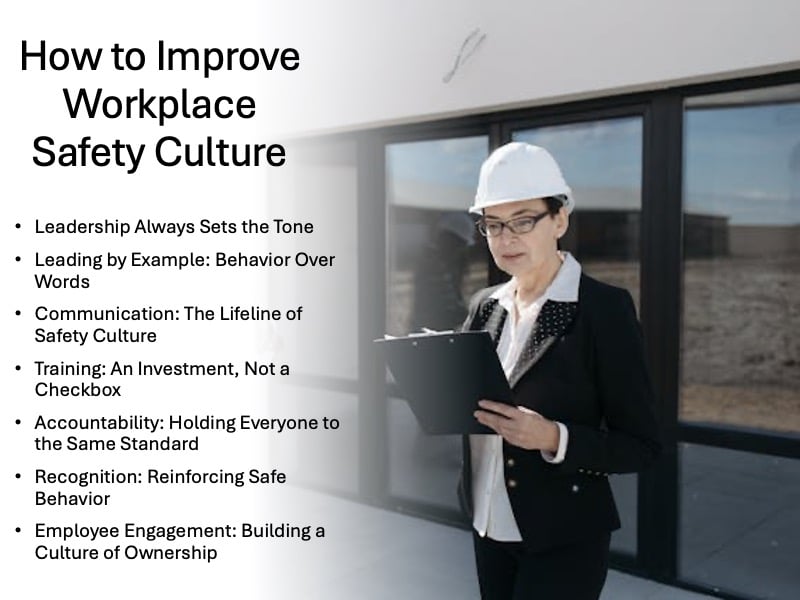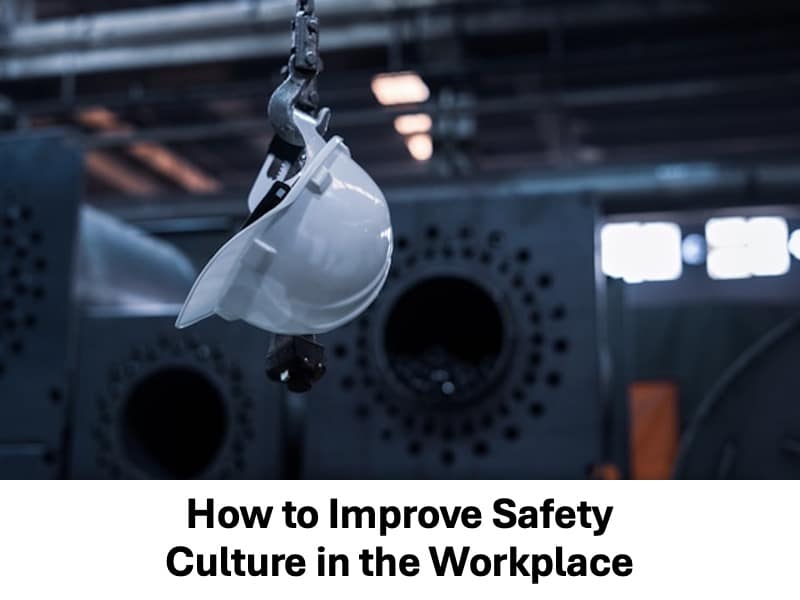How to Improve Safety Culture in the Workplace
Knowing how to improve safety culture in the workplace is critical for reducing injuries, boosting morale, and ensuring long-term operational success.
Workplace safety culture refers to the collective values, behaviors, and attitudes toward safety shared by everyone in an organization, from frontline employees to senior management.
When safety becomes a core organizational value rather than just a policy, workers feel empowered to take responsibility for both their personal safety and that of their peers.
A positive workplace safety culture is built through leadership commitment, ongoing training, clear communication, and shared accountability.
It also evolves over time, requiring consistent effort to maintain and improve.
Companies that invest in changing their workplace safety culture often experience fewer incidents, lower employee turnover, and higher productivity.
Whether you’re looking to reduce risk, comply with regulations, or create a culture of safety that employees trust and value, learning how to improve safety culture in the workplace is a strategic and human-centered priority.
What Is Workplace Safety Culture & Why Is It Important?
Workplace safety culture refers to the collective mindset, values, and behaviors surrounding safety across all levels of an organization.
It goes beyond written policies or compliance checklists, as it reflects how safety is prioritized, communicated, and practiced on a daily basis.
A strong safety culture empowers employees to take initiative, identify hazards, and protect not only themselves but also their coworkers.
Instead of waiting for directions, team members act proactively to minimize risk and promote a safe working environment.
This shared responsibility leads to fewer accidents, greater employee satisfaction, and higher regulatory compliance.
Organizations that emphasize a positive workplace safety culture often enjoy long-term benefits such as improved morale, lower turnover, and increased operational efficiency.
Ultimately, safety culture is a dynamic and evolving system—shaped by leadership, reinforced through daily behavior, and essential for sustainable success.
How to Improve Workplace Safety Culture

Improving workplace safety culture requires more than updated policies or new equipment; it demands a shift in mindset, a commitment from leadership, and increased employee engagement.
A strong safety culture is built through consistent actions, clear communication, and shared responsibility at every level of the organization.
By developing trust, encouraging reporting, and reinforcing safe behavior, companies can create environments where safety becomes second nature and everyone feels accountable.
Leadership Always Sets the Tone
Leaders drive culture, whether intentionally or not.
Their behaviors signal what truly matters, far more than any mission statement. When leaders consistently prioritize safety through actions, communication, and investments, they send a clear message: safety isn’t negotiable.
This creates trust and consistency, laying the groundwork for a lasting safety culture.
That’s why education matters.
Leaders who invest in learning, such as pursuing an occupational health and safety degree online, are better equipped to understand risk, shape policy, and lead by example.
Programs like Southeastern Oklahoma State University’s online bachelor’s in Occupational Safety and Health provide practical training and leadership insight that empower managers to drive meaningful change across industries at just $321 per credit hour.
Leading by Example: Behavior Over Words
Leadership isn’t what you say, it’s what you do, especially when no one’s watching.
A supervisor who wears protective gear, follows procedures, and never cuts corners sets a powerful example.
When frontline employees see this consistency, they’re far more likely to mirror it. If, however, a leader ignores safety guidelines or jokes about shortcuts, it gives permission for others to do the same.
Employees observe leadership closely.
When behavior matches the stated safety goals, culture thrives. When it doesn’t, confusion and mistrust take root.
Leaders who consistently live out their safety commitments become the backbone of a resilient and responsible workforce.
Communication: The Lifeline of Safety Culture
A strong safety culture thrives on honest, open communication. Leaders must make it easy for employees to report hazards, raise concerns, or share suggestions without fear of backlash.
Safety isn’t static, as it evolves with each task, each project, and each new risk.
Without regular communication, dangerous gaps form between policy and practice.
Leaders should engage workers through daily check-ins, safety briefings, and transparent reporting systems.
It’s not just about talking, it’s about listening.
When employees feel heard and respected, they are more likely to speak up.
This leads to faster interventions, more effective training, and a team-wide commitment to staying safe.
Communication is how safety becomes culture.
Training: An Investment, Not a Checkbox
Training isn’t a one-time obligation; it’s an ongoing leadership priority.
When leaders invest time and resources into meaningful safety education, it reinforces the importance of every protocol and prepares workers to respond effectively in real scenarios.
This includes hands-on drills, scenario-based learning, and updated guidance tailored to changing work environments.
Effective training is one of the most powerful tools to avoid injuries in the workplace, but only when it’s treated as an ongoing priority rather than a compliance formality.
Safety training should be dynamic, hands-on, and tailored to real-world scenarios that reflect the evolving demands of each job site or office environment.
Strong leaders go beyond checking boxes.
They attend training sessions alongside their teams, ask thoughtful questions, and promote open dialogue.
Their active involvement reinforces that safety is a core value, not just a regulatory requirement.
When leadership invests in relevant, engaging, and continuous education, it builds confidence, improves decision-making under pressure, and develops a culture where everyone is prepared to respond safely, every time.
Accountability: Holding Everyone to the Same Standard
Accountability builds credibility.
When leaders hold themselves to the same safety standards they expect from employees, it demonstrates integrity.
If an executive expects workers to report near misses or follow lockout-tagout procedures, they must do the same.
Double standards, where upper management is excused from rules, undermine trust and weaken safety culture.
Clear policies matter, but enforcement must be consistent.
Leaders should reinforce positive behavior with recognition while addressing violations promptly and effectively.
Regular audits and transparent incident reviews show that safety isn’t optional; it’s essential.
In cultures with shared accountability, safety becomes a team responsibility rather than a top-down directive.
Recognition: Reinforcing Safe Behavior
People repeat what gets rewarded.
When leaders acknowledge safe behavior, they reinforce the value of those actions.
A simple shoutout during a morning meeting or a small incentive for a safety milestone can shift how employees view risk and responsibility.
Recognition doesn’t have to be flashy; it just has to be sincere.
Leadership should celebrate safety improvements as actively as they track productivity.
Teams that consistently meet safety goals deserve recognition, not just when incidents are avoided, but when proactive steps are taken.
Positive reinforcement helps embed safety into daily habits and strengthens morale, engagement, and team pride.
Employee Engagement: Building a Culture of Ownership
Safety culture cannot thrive if employees feel like passive participants.
Leadership must encourage active involvement at every level.
That means inviting frontline workers into safety planning discussions, listening to their input on risks, and giving them ownership over safety outcomes.
People support what they help create.
Leaders can form safety committees, promote peer-to-peer mentoring, and encourage innovation in hazard prevention.
When employees understand that their voices matter, they remain engaged.
Leadership isn’t about commanding from a distance; it’s about building connections and empowering others.
Engaged teams notice problems early, act faster, and help build a workplace where everyone looks out for each other.
Leadership shapes safety culture from the top down, but its impact spreads in every direction.
When leaders prioritize wellbeing, lead by example, communicate openly, and empower others, safety becomes more than a requirement; it becomes a shared value.
A strong safety culture protects people, enhances performance, and creates workplaces where trust thrives.
It takes effort, but it begins with leaders who care enough to take action.
Final Thoughts: Is it Possible to Improve Safety Culture in the Workplace?
Improving safety culture in the workplace is not only possible but essential for creating environments where employees feel protected, valued, and motivated.
Whether in high-risk industries or office settings, a strong safety culture begins with leadership but thrives through shared accountability, open communication, and continuous learning.
Companies that invest in safety improvements often see a ripple effect, reducing injuries in the workplace, boosting morale, and even preventing burnout from work by showing genuine concern for employee well-being.
Small, intentional steps, such as daily safety check-ins, leadership modeling of proper behaviors, or promoting ergonomic practices and health tips for office workers, can build long-term trust and engagement.
Safety culture isn’t static. It grows through consistency, care, and collaboration—proving that any workplace can evolve into a safer, healthier space when people commit to change together.
This website does not provide medical advice. This website site does contain affiliate links, and purchases may earn a commission.
Read my Medical Disclaimer, Review Disclaimer, and Publishing Policies for more details. Use of this site indicates acceptance of these terms.



